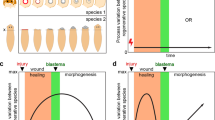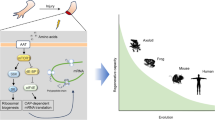Abstract
I discuss in this chapter the use of exaptation to create serendipity in an important biological process such as regeneration and in cancer. Regeneration is the capability to replace parts of the body lost after injury. As the immune system increases its complexity, this capacity decreases but, in the parts that are able to regenerate, we found a common signature between mammals and very distant organisms with high regenerative capacity such as Hydra, planaria and sea cucumber. On the other hand, tumour cells use the same genes related to Epithelial Mesenchymal Transition (EMT) to become more prone to migrate and to acquire an aggressive phenotype. Finally, I will discuss how the era of “Big Data” is helping us to identify processes that use exaptation to create serendipity.
Access this chapter
Tax calculation will be finalised at checkout
Purchases are for personal use only
Similar content being viewed by others
References
Agata K, Saito Y, Nakajima E (2007) Unifying principles of regeneration I: epimorphosis versus morphallaxis. Dev Growth Differ 49:73–78
Alvarado A, Tsonis P (2006) Bridging the regeneration gap: genetic insights from diverse animal models. Nat Rev Genet 7:873–884
Easwaran H, Tsai HC1, Baylin SB (2014) Cancer epigenetics: tumor heterogeneity, plasticity of stem-like states, and drug resistance. Mol Cell 54:716–727
Font Clos F, Zapperi S, La Porta C (2018) Topography of epithelial–mesenchymal plasticity. PNAS 115:5902–5907
Fumagalli MR, Zapperi S, LaPorta C (2018) Regeneration in distantly related species common strategies and pathways. NPJ Syst Biol Appl 4. https://doi.org/10.1038/s41540-017-0042-z
Gilgenkrantz H, Collin de l’Hortety A (2018) Understanding liver regeneration from mechanisms to regenerative medicine. Am J Pathol 188:1316–1327
Godwin JW (2014) The promise of perfect adult tissue repair and regeneration in mammals: learning from regenerative amphibians and fish. BioEssays 36:861–871
Godwin JW, Rosenthal N (2014) Scar-free wound healing and regeneration in amphibians: immunological influences on regenerative success. Differentiation 87:66–75
Hartmann HT, Kester DE, Davies FT, Geneve R (2010) Hartmann & Kester’s plant propagation: principles and practices, 8th edn. Prentice-Hall, Englewood Cliffs, NJ, USA
La Porta CAM, Zapperi S (2017) Complexity in cancer stem cells and tumor evolution: towards precision medicine. Semin Cancer Biol 44:3–9
La Porta CAM, Zapperi S (2018) Explaining the dynamics of tumor aggressiveness: at the crossroads between biology, artificial intelligence and complex systems. Semin Cancer Biol 53:42–47
Melnyk CW, Schuster C, Leyser O, Meyerowitz EM (2015) A developmental framework for graft formation and vascular reconnection in Arabidopsis thaliana. Curr Biol 25:1306–1318
Mescher AL, Neff AW (2005) Regenerative capacity and the developing immune system. Adv Biochem Eng Biotechnol 93:39–66
Mescher AL, Neff AW, King MW (2017) Inflammation and immunity in organ regeneration. Dev Comp Immunol 66:98–110
Pibiri M, Sulas P, Leoni VP, Perra A, Kowalik MA, Cordella A, Saggese P, Nassa G, Ravo M (2015) Global gene expression profile of normal and regenerating liver in young and old mice. AGE 37:9796
Pulianmackal AJ, Kareem AVK, Durgaprasad K, Trivedi ZB, Prasad K (2014) Competence and regulatory interactions during regeneration in plants. Front Plant Sci 11. doi.org/10.3389/fpls.2014.00142
Reddien PW, Alvarado SA (2004) Fundamentals of planarian regeneration. Annu Rev Cell Dev Biol 20:725–757
Sellerio AL, Ciusani E, Bossel Ben-Moshe N, Coco S, Piccinini A, Myers CR, Sethna JP, Giampietro C, Zapperi S, La Porta CAM (2015) Overshoot during phenotypic switching of cancer cell populations. Sci Rep 5:15464
Siebert S, Farrell JA, Cazet JF, Abeykoon YL, Primack AS, Schnitzler CE, Juliano CE (2019) Stem cell differentiation trajectories in Hydra resolved at single-cell resolution 365:eaav9314
Steinway SN, Zañudo JGT, Michel PJ, Feith DJ, Loughran TP, Albert R (2015) Combinatorial interventions inhibit TGFβ-driven epithelial-to-mesenchymal transition and support hybrid cellular phenotypes. NPJ Syst Biol Appl 1, Article number: 15014
Stewart R, Rascón CA, Tian S, Nie J, Barry C, Chu LF, Ardalani H, Wagner RJ, Probasco MD, Bolin JM, Leng N, Sengupta S, Volkmer M, Habermann B, Tanaka EM, Thomson JA, Dewey CN (2013) Comparative RNA-seq analysis in the unsequenced axolotl: the oncogene burst highlights early gene expression in the blastema. PLoS Comput Biol 9:e1002936
Thiery JP, Acloque H, Huang YJ, Nieto MA (2009) Epithelial-mesenchymal transitions in development and disease. Cell 139:871–890
Wagner DE, Wang IE, Reddien PW (2011) Clonogenic neoblasts are pluripotent adult stem cells that underlie planarian regeneration. Science 332:811–816
Wahl GM, Spike BT (2017) Spike cell state plasticity, stem cells, EMT, and the generation of intra-tumoral heterogeneity. NPJ Breast Cancer 3:14
Xu C, Chen X, Chang C, Wang G, Wang W, Zhang L, Zhu Q, Wang L, Zhang F (2010) Transcriptome analysis of hepatocytes after partial hepatectomy in rats. Dev Genes Evol 220:263–274
Zhang X, Sun L, Yuan J, Sun Y, Gao Y, Zhang L, Li S1, Dai H, Hamel JF, Liu C, Yu Y, Liu S, Lin W, Guo K, Jin S, Xu P, Storey KB, Huan P, Zhang T, Zhou Y, Zhang J, Lin C, Li X, Xing L, Huo D, Sun M, Wang L, Mercier A, Li F, Yang H, Xiang J (2017) The sea cucumber genome provides insights into morphological evolution and visceral regeneration PLoSBiol 15:e2003790
Author information
Authors and Affiliations
Corresponding author
Editor information
Editors and Affiliations
Rights and permissions
Copyright information
© 2020 Springer Nature Switzerland AG
About this chapter
Cite this chapter
La Porta, C.A. (2020). Exaptation for the Good and the Bad: Regeneration and Cancer. In: La Porta, C., Zapperi, S., Pilotti, L. (eds) Understanding Innovation Through Exaptation. The Frontiers Collection. Springer, Cham. https://doi.org/10.1007/978-3-030-45784-6_4
Download citation
DOI: https://doi.org/10.1007/978-3-030-45784-6_4
Published:
Publisher Name: Springer, Cham
Print ISBN: 978-3-030-45783-9
Online ISBN: 978-3-030-45784-6
eBook Packages: Physics and AstronomyPhysics and Astronomy (R0)




